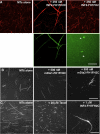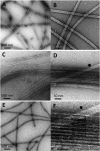Differential interactions of the formins INF2, mDia1, and mDia2 with microtubules
- PMID: 21998204
- PMCID: PMC3226476
- DOI: 10.1091/mbc.E11-07-0616
Differential interactions of the formins INF2, mDia1, and mDia2 with microtubules
Abstract
A number of cellular processes use both microtubules and actin filaments, but the molecular machinery linking these two cytoskeletal elements remains to be elucidated in detail. Formins are actin-binding proteins that have multiple effects on actin dynamics, and one formin, mDia2, has been shown to bind and stabilize microtubules through its formin homology 2 (FH2) domain. Here we show that three formins, INF2, mDia1, and mDia2, display important differences in their interactions with microtubules and actin. Constructs containing FH1, FH2, and C-terminal domains of all three formins bind microtubules with high affinity (K(d) < 100 nM). However, only mDia2 binds microtubules at 1:1 stoichiometry, with INF2 and mDia1 showing saturating binding at approximately 1:3 (formin dimer:tubulin dimer). INF2-FH1FH2C is a potent microtubule-bundling protein, an effect that results in a large reduction in catastrophe rate. In contrast, neither mDia1 nor mDia2 is a potent microtubule bundler. The C-termini of mDia2 and INF2 have different functions in microtubule interaction, with mDia2's C-terminus required for high-affinity binding and INF2's C-terminus required for bundling. mDia2's C-terminus directly binds microtubules with submicromolar affinity. These formins also differ in their abilities to bind actin and microtubules simultaneously. Microtubules strongly inhibit actin polymerization by mDia2, whereas they moderately inhibit mDia1 and have no effect on INF2. Conversely, actin monomers inhibit microtubule binding/bundling by INF2 but do not affect mDia1 or mDia2. These differences in interactions with microtubules and actin suggest differential function in cellular processes requiring both cytoskeletal elements.
Figures








Similar articles
-
Mechanistic differences in actin bundling activity of two mammalian formins, FRL1 and mDia2.J Biol Chem. 2006 May 19;281(20):14383-92. doi: 10.1074/jbc.M510923200. Epub 2006 Mar 23. J Biol Chem. 2006. PMID: 16556604
-
Essential and nonredundant roles for Diaphanous formins in cortical microtubule capture and directed cell migration.Mol Biol Cell. 2014 Mar;25(5):658-68. doi: 10.1091/mbc.E13-08-0482. Epub 2014 Jan 8. Mol Biol Cell. 2014. PMID: 24403606 Free PMC article.
-
The filamentous actin cross-linking/bundling activity of mammalian formins.J Mol Biol. 2008 Dec 12;384(2):324-34. doi: 10.1016/j.jmb.2008.09.043. Epub 2008 Sep 26. J Mol Biol. 2008. PMID: 18835565
-
Coordination of microtubule acetylation and the actin cytoskeleton by formins.Cell Mol Life Sci. 2018 Sep;75(17):3181-3191. doi: 10.1007/s00018-018-2855-3. Epub 2018 Jun 15. Cell Mol Life Sci. 2018. PMID: 29947928 Free PMC article. Review.
-
Formins as effector proteins of Rho GTPases.Small GTPases. 2014;5:e29513. doi: 10.4161/sgtp.29513. Epub 2014 Jun 10. Small GTPases. 2014. PMID: 24914801 Free PMC article. Review.
Cited by
-
Splice variant-specific cellular function of the formin INF2 in maintenance of Golgi architecture.Mol Biol Cell. 2011 Dec;22(24):4822-33. doi: 10.1091/mbc.E11-05-0457. Epub 2011 Oct 12. Mol Biol Cell. 2011. PMID: 21998196 Free PMC article.
-
Investigating Mammalian Formins with SMIFH2 Fifteen Years in: Novel Targets and Unexpected Biology.Int J Mol Sci. 2023 May 21;24(10):9058. doi: 10.3390/ijms24109058. Int J Mol Sci. 2023. PMID: 37240404 Free PMC article. Review.
-
New insights into the role of plant formins: regulating the organization of the actin and microtubule cytoskeleton.Protoplasma. 2012 Jun;249 Suppl 2:S101-7. doi: 10.1007/s00709-011-0368-0. Epub 2012 Jan 4. Protoplasma. 2012. PMID: 22215231 Review.
-
Microtubules and Microtubule-Associated Proteins.Cold Spring Harb Perspect Biol. 2018 Jun 1;10(6):a022608. doi: 10.1101/cshperspect.a022608. Cold Spring Harb Perspect Biol. 2018. PMID: 29858272 Free PMC article. Review.
-
Formin 3 stabilizes the cytoskeleton of Drosophila tendon cells, thus enabling them to resist muscle tensile forces.J Cell Sci. 2025 Apr 1;138(7):jcs263543. doi: 10.1242/jcs.263543. Epub 2025 Apr 11. J Cell Sci. 2025. PMID: 40084430 Free PMC article.
References
-
- Al-Bassam J, Roger B, Halpain S, Milligan RA. Analysis of the weak interactions of ADP-Unc104 and ADP-kinesin with microtubules and their inhibition by MAP2c. Cell Motil Cytoskeleton. 2007;64:377–389. - PubMed
-
- Azoury J, Lee KW, Georget V, Rassinier P, Leader B, Verlhac MH. Spindle positioning in mouse oocytes relies on a dynamic meshwork of actin filaments. Curr Biol. 2008;18:1514–1519. - PubMed
Publication types
MeSH terms
Substances
Grants and funding
LinkOut - more resources
Full Text Sources
Miscellaneous

